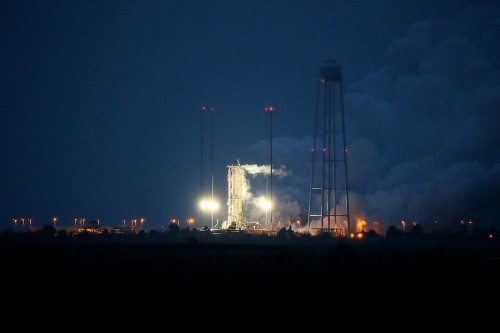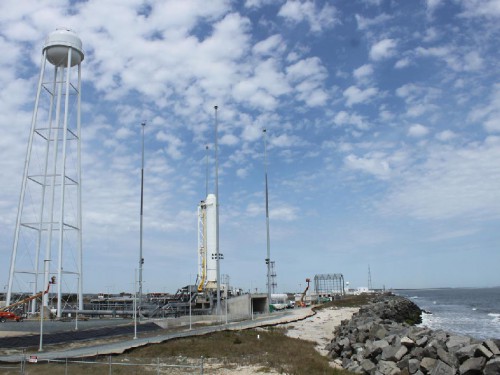
Twenty-nine seconds might not seem like much, but for Orbital Science Corporation it was 29 seconds of pure victory. NASA and Orbital conducted a successful hot firing of the company’s Antares rocket at 6 p.m. EST at the United State’s newest launch complex. The “hot-fire” test, as it is called, took place at NASA’s Wallops Flight Facility’s Mid-Atlantic Regional Spaceport (MARS) Pad-0A.
The test involved not only the checking out of the Antares twin AJ26 engines, but also the launch pad’s fueling systems in preparation for planned flights of this new launch vehicle. The test helped validate the readiness of the Antares first stage and is the last major milestone that has to be completed in preparation for the rocket’s maiden flight, planned for later this year.
“Today’s successful stage test positions us one step closer to supporting Orbital’s historic flight test,” said Aerojet Vice President of Space & Launch Systems Julie Van Kleeck. “We’re proud to deliver for the Antares team, and we’re looking forward to continuing the countdown toward the inaugural mission.”
The AJ26 engine is supplied by Aeorjet, which purchased the NK-33 engines from a Russian rocket manufacturer in the mid-90s and has since redubbed it the AJ26. The AJ26 is described by Aerojet as being an “oxidizer-rich, staged-combustion LO2/Kerosene engine.” Under this test, these engines were kept bolted down—even as they produced 68,000 lbs of thrust.
“Aerojet purchased the NK-33 engines from JSC Kuznetsov in the mid-1990s and has been developing design modifications to ensure that the AJ26 is suitable for U.S. commercial launch vehicles,” said Aerojet’s Executive Director of Space & Launch Systems Pete Cova. “As teammates, JSC Kuznetsov brings tremendous technical support to our efforts, and we are looking forward to supporting Orbital in its Cargo Resupply Contract with NASA.”

Orbital is a commercial space firm that, like Space Exploration Technologies, or “SpaceX,” is developing a rocket, the Antares, as well as the Cygnus cargo vessel under NASA’s Commercial Orbital Transportation Services (COTS) contract. SpaceX has already completed COTS’ objectives and has moved on to actual resupply flights to the International Space Station under NASA’s Commercial Resupply Services (CRS) contract.
With the “hot-fire” test out of the way, Orbital is now poised to conduct a demonstration flight of the Antares. This mission will not carry a Cygnus spacecraft, which will be reserved for the following flight. The first Orbital will conduct under COTS. If Orbital can accomplish COTS’ requirements, it can begin conducting CRS flights. There is a lot riding on the success of this and upcoming missions as NASA has a $1.9 billion contract with Orbital under CRS.
“This pad test is an important reminder of how strong and diverse the commercial space industry is in our nation,” said Phil McAlister, director of NASA’s Commercial Spaceflight Development. “A little more than one year after the retirement of the space shuttle, we had a U.S company resupplying the International Space Station. Now, another is taking the next critical steps to launch from America’s newest gateway to low-Earth orbit. Today marks significant progress for Orbital, MARS, and the NASA team.”
NASA’s Wallops facility provided more than just a backdrop for the “hot-fire” test. More than 16,000 rockets have been sent aloft during the facility’s 67-year history. The personnel working there provided communications, data collection, range safety, and other forms of launch range support.
NASA has been working to empower a number of smaller, private space companies to take over the role of sending cargo into low-Earth orbit as the space agency focuses on sending crew beyond the orbit of Earth for the first time in more than four decades. To date, none of these companies has launched any crew, and, as mentioned, only two unmanned flights to the International Space Station have been conducted by SpaceX.
Missions » ISS » COTS » Missions » A-ONE »



Um, er, ah, wow! We’re moving steadily closer to proving the wonderfulness of commericial space flight. Except … 1996 rocket engines? This is on a par with demonstrating that Intel Pentium (80586) computer chips will successfully run Windows 95! What magificance is next? Demonstrating that computers running Windows 98 can actually access the Internet?
We’re doing stuff WRONG in the aerospace business, I suggest.
They’re more like 70’s engines, production stopped on them with the demise of the N-1 program. They were just purchased in the 90s. But that’s not to say an old design isn’t a valid design, and Aerojet supposedly adjusts the ones they purchased. They also hold a license to build more of their own, though likely a modified version. Still, why is using existing, perfectly good engines doing things wrong?
Well… I have a perfectly good single processor PC on my desktop that I run Win 98 and Win 2K and PC-DOS on, and it’s just fine for 1990’s vintage games. So I’m not going to kick too much at “old technology.”
Still… some time has passed since the 1990’s (or the 1970’s). We ought to have better more-heat resistant alloys for building rocket engines. We have better faster computers and better software for simulating aerodynamics than in those days, which might be used to investigate better engine shapes and better fuel injection designs. We might be considering the possibilities of rockets which switch from H2-Kerosine to H2-O2 burning mid ascent. We might be wondering if some way can be found for pilot (or software) control of burning rates in solid rocket motors. We might be pondering the use of disposable liners that would leave the greater part of rocket engines reusable for future missions. We might dream of using ionized or excited-state molecules as propellants. In our deepest, darkest, most private fanatasies we might consider using nuclear propulsion for manned interplanetary flight.
At which point in the previous paragraph did you (and other sane readers) begin vomiting?
Apples vs Oranges… Semiconductors followed Moore’s law (doubling the number of transistors every 18 months) representing a self sustaining business opportunity – make more by making it smaller using higher and higher freq of light (now hitting the limits of physics btw). Since they found applications in so many things in our world it might seem that everything in technology should move at the same pace. Disk drives seem to have evolved (and they are mechanical right?) at the same pace… but really because they use a semiconductor technology – the magnetic read/write head – Moore’s law again.
Rocket Engines are much more of a mechanic design challenge; yes computers help to control creating and building better alloys for the engine bell, the turbo pumps etc., but it’s a small incremental benefit. BTW one of the greatest rocket engines ever built, still unsurpassed is the F1 Engine of the Apollo – designed in Canoga Park, CA by Rocketdyne (North American Rockwell) by engineers using slide rules 😉